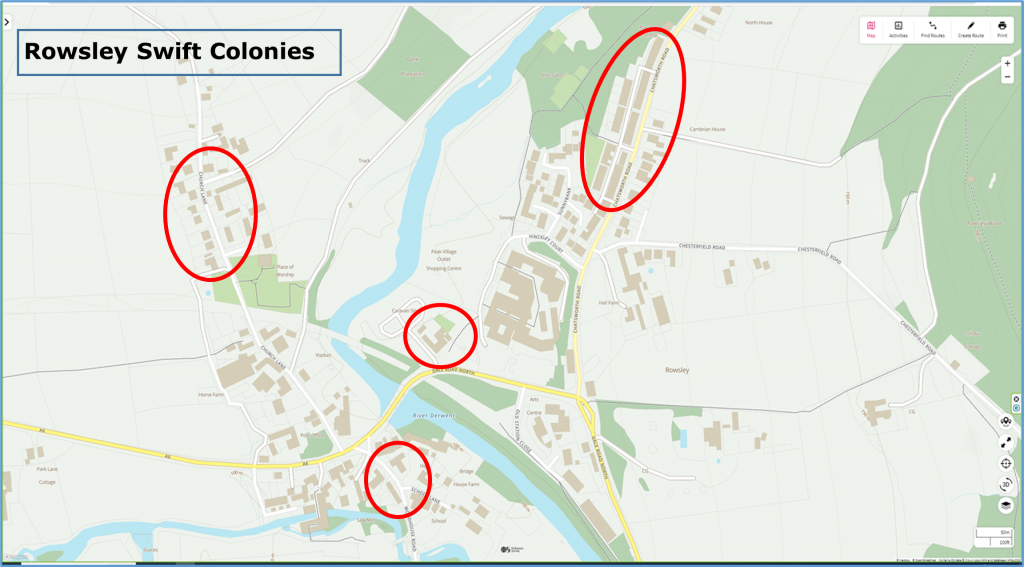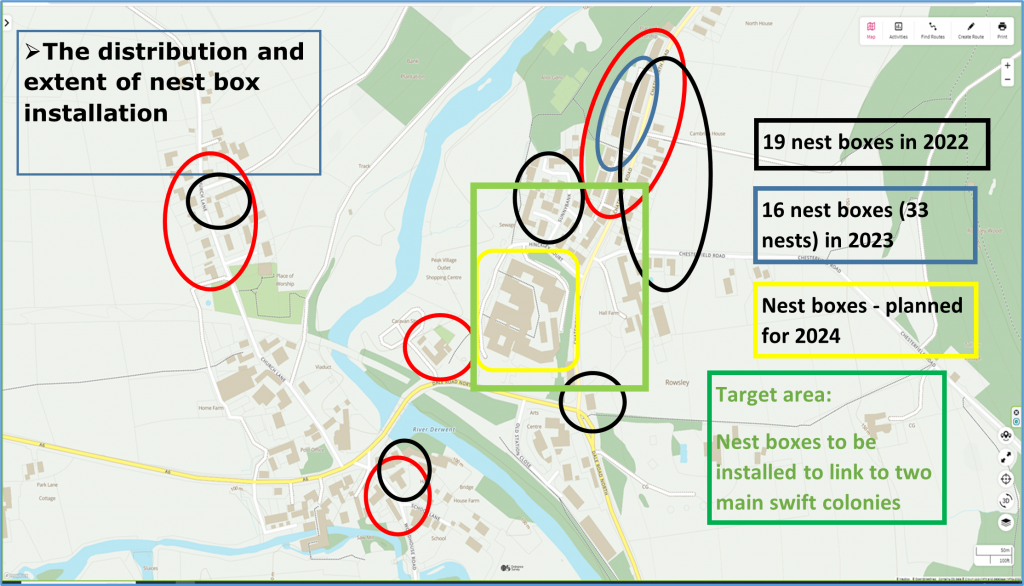The village of Rowsley, situated at the confluence of the Derwent & Wye rivers in the Derbyshire Dales and located between the towns of Bakewell & Matlock and the Chatsworth & Haddon estates, has an interesting history linked to the numerous mills that lay along both rivers and the arrival of the railway in 1849. Rowsley’s claim to fame is that Rowsley station was used by King Edward VII when visiting the Chatsworth Estate. The line was closed in 1967 but further up towards Bakewell it is now the Monsal Trail, a hugely popular recreational facility.
Today, however, Rowsley is better known for its Swifts. The village, with a human population of 500, hosts what is probably the highest density of breeding Swifts in the Derbyshire Dales, if not in the whole of Derbyshire.
This blog will be the first of a series viewing Rowsley’s Swifts from different viewpoints and this colony was the subject of a talk to the national Swift Local Network (SLN) at its recent meeting in Oxford. Here we describe the status of the Swift population in the village and summarise the efforts being made to conserve this remarkable breeding colony.
The presence of significant numbers of breeding Swifts was first noted in 2021 and three surveys have been carried out since, the most recent taking place in the summer of 2023. In total over 60 Swift nests have been found, distributed across four distinct clusters or colonies.

The biggest colony is along Chatsworth Road, where there are 31 swift nests, all to the west of the road. These properties are either privately owned ex-social housing or are owned and rented out by Platform Housing, a housing association.

The second colony is at the Grouse & Claret public house, which has at least 21 nests on a single building.

The third and fourth colonies are located on the other side of the Derwent River located in the older (west) side of the village, on Church Lane (7 nests on 3 properties) and School Lane where 4 nests were identified on the back of the terrace of houses opposite the village hall.
Looked at in isolation, these are important numbers, but their significance takes on a much greater importance when the ownership of the properties upon which these colonies are located, is taken into consideration.
| Property Owner | Number of Swift Nests |
| Marston’s Brewery (Grouse & Claret) | 21 |
| Platform Housing | 17 |
| Privately-owned ex-social houses | 13 |
| Private houses | 10 |
At some stage in the future Marston’s Brewery, which owns the pub, will renovate the annex building which hosts virtually all the Swifts nesting on the Grouse & Claret. Likewise, Platform Housing will re-roof the properties with Swift nests on Chatsworth Road and the private owners of properties in the same location will undoubtedly be considering a similar course of action, although over a longer timescale.
In short, if we do nothing, it is inevitable we will lose over 80% of Rowsley’s breeding Swifts.
It is for this reason that the Rowsley Swift Project is a lot more than just an annual survey. Since 2021, when the significance of Rowsley became evident, we have been planning and acting to pre-empt the imminent destruction of 2 significant breeding colonies, approaching the problem from three different angles.
Firstly, we’ve engaged in an on-going programme of raising public awareness, by means of talks, educational visits to the local school, articles in the Parish Magazine and walks round the village to coincide with Swift Awareness Week which takes place nationally every July. The objectives have been to discuss Swifts and how their presence is intrinsic to summers in the village, the decline of the Swift population in general, the importance of the Rowsley Swift colony and, finally, how we can help conserve Swifts through protection of nest sites and use of nest boxes.
The second approach has required interaction with the two of the key landlords in the village, Platform Housing and Marston’s Brewery, both of which are slowly yielding results. In both cases the aim is not to try and prevent this work being done but, instead, to encourage these organisations to work with us in developing ways to ensure that the continued provision of Swift nests sites is an integral part of the planned renovations.
The third approach is a nest box programme designed to diversify the location of nest sites across the village. The more Swifts use nest boxes, the greater the chance we can maintain the Rowsley population even if a major colony is destroyed. So far, thanks to a combination of grants, private purchases of nest boxes and funding from Platform Housing, we have installed a total of 35 Swift nest boxes on properties in Rowsley. Some of these were double or treble boxes, so the actual number of nest sites provided now totals 52. We are currently negotiating with the Chatsworth Estate in the hope that they will agree to purchase and install some large feature nest boxes at locations around Peak Village shopping complex.
We hope to continue the provision of supplementary nest sites in 2024, stimulating demand by holding more events to maintain local awareness of the importance of Rowsley as a Swift “hotspot”.

Acknowledgments
With thanks to Claire Mead for co-ordinating and reporting on the 2022 and 2023 Swift surveys, Mark Lloyd, Chrissy Grocott, Julia Hutchinson, Sue Bliss, Jenny Downing, Lucy Robson, Sheila & Ken Evans, Nigel Smith and Andy Broadhurst for assisting with surveys.
Platform Housing and Councillor Buckler for kind donations
Jan Bullett for the 2022 box installation.
With thanks to the residents who support the Swift survey by allowing access to their gardens: Beverley & Kevin Bagshaw; Gail Robinson; and Sandra Jenkins.
